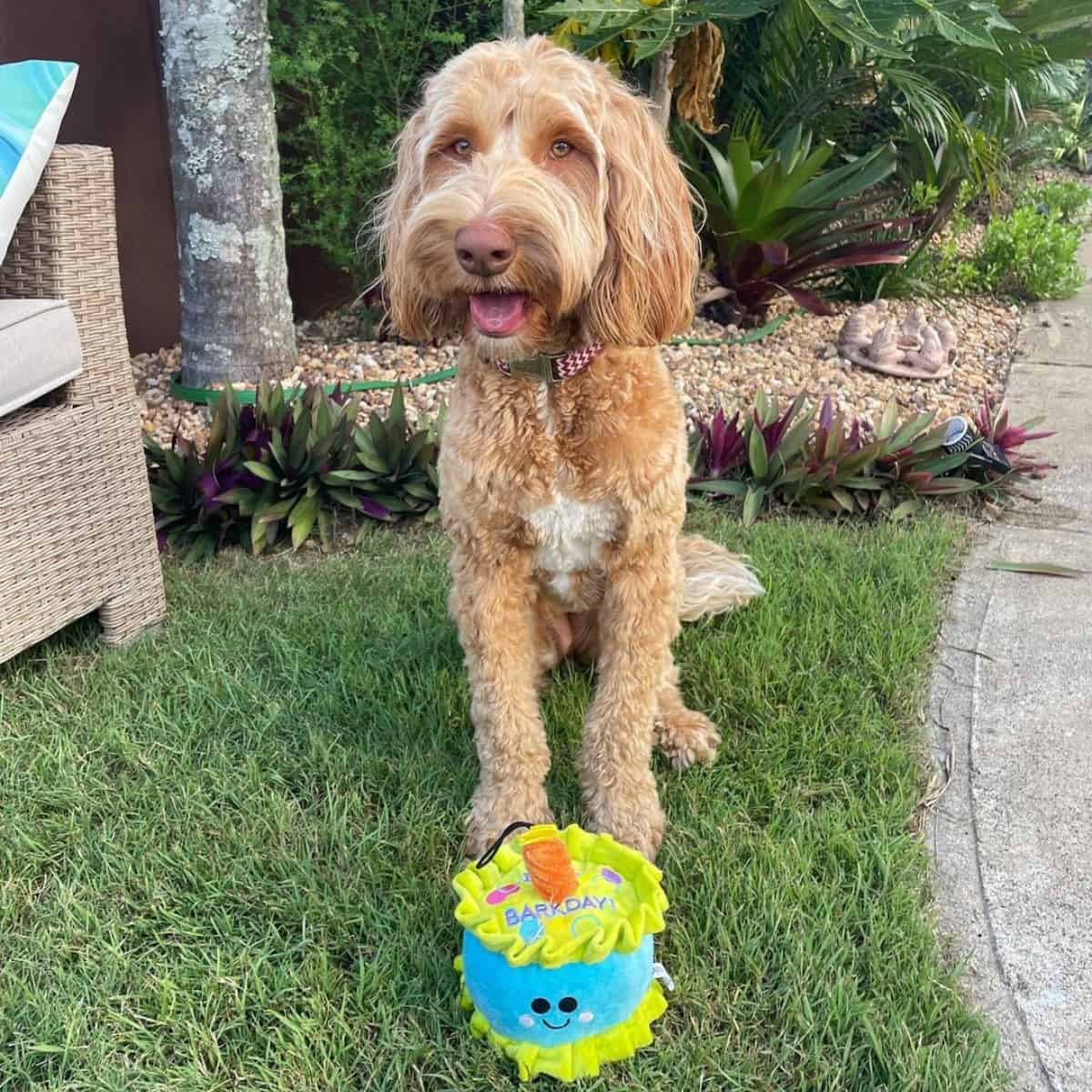How Much Do Labradoodles Weigh? [All Sizes]
The Labradoodle is the outcome of a cross between a Labrador and a Poodle. It is a breed that is increasingly growing in popularity. Initially, it was bred for hypoallergenic dog owners, but today, they’re one of the most loved breeds worldwide.
When it comes to size, Labradoodles can range from miniature to medium and standard. Here’s a closer look at their different sizes and weights.

Although they make excellent service dogs, families can enjoy them as pets because of their intelligent and intuitive personality. Beyond that, people value their endearing nature and often non-shedding coats.
These intelligent dogs are unique-there is no one-size shape, color, or size for this breed. This is why each puppy differs slightly from its siblings. The variations are vast, while some have a shaggy coat, others a curly one.
The Weight and Size of an Adult Labradoodle

An adult Labradoodle’s size will depend purely on its parent’s. Suppose you weren’t looking for a large dog. In that case, you’d be relieved to know that Labradoodles fall under the classification of medium-sized dogs. It’s worth noting that a fully grown labradoodle shouldn’t be bigger than 24 inches in height.
When selecting this breed, ask the breeder or the vet about the parents’ size. This information will clue you in on how big your Labradoodle will be when it becomes an adult.
The smallest variety of the breed (Mini Labradoodle) is the outcome of a cross between a miniature Poodle and a Labrador Retriever. In such cases, adult males outweigh adult females by 10-15 pounds, although this isn’t always the case.
Other factors that could impact adult weight include food, birth order, feeding schedule, and health. However, the significant influence on your dog’s size is the size of each parent.
The more uniform the size between the parent dogs, the easier it becomes to predict your Labradoodle’s adult size. It can be challenging to determine the precise size of a Labradoodle puppy as an adult because of its hybrid nature.
When two pedigrees merge, each pup in the litter gets different genes. For instance, some puppies might resemble Labrador Retrievers while others might match Poodles’ appearance and behavior. This is why it isn’t possible to predict precisely how each pair of genes will influence a puppy in a given litter.
The Weight of an Adult Labradoodle When Bred from a Standard-Sized Poodle

If either of the parents was standard-sized, the outcome would be a bigger variation of the breed. A standard-sized adult poodle’s height ranges between 45 and 60 cm (17-23 inches).
On the other hand, an adult Labrador can be between 55 and 62 cm (21-24 inches) in height. So you can expect an adult Labradoodle to generally be between 53 and 63 cm, or 20-24 inches in height.
Gender doesn’t change the outcome by much-standard-sized Labradoodle females are between 21 and 23 inches. In comparison, the males range between 22 and 24 inches tall. The dog’s weight can vary between 23 and 30 kgs (50-66 lbs) from this mix.
A standard Labradoodle is active and enjoys playing and running. Consequently, they require room and aren’t ideal for tiny apartment living.
The Weight of a Labradoodle if Bred with a Medium-Sized Poodle

Medium Labradoodles have a standard Labrador parent and a medium-sized Poodle parent. Most Medium Labradoodle dogs will measure between 43 and 52 cm (16-22 inches) when fully grown.
Males tend to be taller and can grow between 18 and 20 inches.
A medium-sized Labradoodle can weigh between 13 and 20 kg (28-44 lbs). This variation makes them just small enough to be lap dogs and large enough to make for excellent companions for a game of throw and catch.
The Weight of Labradoodles if one Parent is a Miniature-Sized Poodle

Mini Labradoodles born of miniature-sized poodles are in great demand because of their hypoallergenic traits and miniature size. They’re somewhat lighter than other breeds-an adult weighs 13 kgs at most.
When fully grown, a Mini Labradoodle weigh between 7 and 13 kgs (15-28 lbs). This much sought-after variation makes an excellent lap dog for apartment owners and is a popular option for families with kids.
My Labradoodle max weights 7 kilograms, which makes hima bout as small as Labradoodle gets. In fact he is sometimes referred to as a Teacup Labradoodle (or micro mini Labradoodle) – but this is just a descriptive name rather than a real size. He is part of a multi generational Labradoodle lineage that have all trended smaller.
At What Age Do Labradoodles Attain Their Full Height?

The age at which they become fully grown is dependent on the parent and type of dog breed. They exhibit rapid growth until they reach about seven months, at which point the process becomes steady.
Most Labradoodles attain full height by age two, although intellectual growth continues after as well. To ensure that your Labradoodle is the healthiest it can be, you can speak with a vet or the breeder about ideal food and nutrition.
At What Point Does a Labradoodle Stop Growing?

Most dogs stop piling on inches a year or 18 months post-birth. Your Labradoodle is no different. And while you might notice that your Labradoodle is no more than knee-high, it might continue to ‘fill out.’ It is difficult to say for how long as they are a hybrid breed and there is no ‘standard’ size. Most owners have reported that weight and cognitive development will continue even after age two.
Keep in mind that while your Labradoodle’s physical development depends on genetics, in part, it also depends on you.
What you feed your Labradoodle and the mental and physical stimulation you provide your canine buddy will ultimately decide its growth and the final Labradoodle size.
What’s a Healthy Weight for Your Labradoodle?

The best way to determine your dog’s healthiest weight is through a scheduled visit to the vet. They’ll inform you of the most suitable dog weight per their age, gender, breed, and other factors.
A healthy weight can be challenging to define, especially if a dog has been overweight for an extended period or since birth.
Some factors could predispose your dog to weight gain. For instance, female dogs have a higher likelihood of gaining weight. The same applies to unneutered dogs; the incidence of obesity in neutered female and male dogs is higher than in unneutered dogs.
How to Maintain Your Labradoodle’s Healthy Weight

Do you know that what you feed your dog is associated with his lifespan? A considerable percentage of dogs that vets examine are overweight. And obese pets typically have a shorter lifespan.
Vets assert that pet owners are primarily responsible for their dog’s unhealthy weight. Maintaining your labradoodle at an ideal weight will increase its lifespan considerably, so consider these weight management tips.
1. Adopt Controlled Feeding
Most dogs thrive with regulated feeding situations. When a pet owner follows a proper feeding regimen, dogs obtain a precise quantity of food daily depending on their nutritional needs and weight.
If you’re uncertain about your labradoodle’s nutritional needs, consult your vet or follow the food label’s recommendations.

2. Don’t Feed Them Human Food
Feeding your labradoodle human food regularly is a mistake you want to avoid at all costs. To begin with, not all human food is safe for dog consumption. Some might even be deadly. Raw pork in particular is not super dog friendly. You want to stick to dog food, which is nutritionally balanced for your pet.
Beware that excess human food could lead to nutritional deficiencies, or your pet might receive an excess of particular nutrients. You should also avoid feeding them raw food like meats, vegetables, and fruits regularly. If you must feed your pet raw food, make it occasional.
Some calorie free or low energy treats like carrot or bell peppers for dogs are popular to reduce treat intake during intense training.
3. Weigh Your Labradoodle
It would be best if you monitor your dog’s weight. This might be difficult to achieve if you have an older dog. Human weighing machines weren’t designed to accommodate four legs. You might need a vet visit to get a precise weight.
For smaller pets, you could simply use a household scale, which is easy to operate.
By frequently monitoring your pet’s weight, you’ll know whether they’re stable or fluctuating. This will indicate whether your canine buddy is getting sufficient exercise and adequate quantities of food. Should you see a considerable difference, speak with a vet about their present diet and exercise schedule.

4. Restrict Treats
While it might be tempting to give your Labradoodle treats for all sorts of reasons, limit treats to special occasions.
Specifically, calories from treats shouldn’t constitute over 10% of your dog’s caloric intake.
You could make healthy treats that are low in calories, for instance, blueberries (my Labradoodle Max’s absolute favorite) or leftover veggies like asparagus. This will help keep their weight under control. Remember, you don’t have to treat your dog whenever they do something.
5. Regular Exercise
Maintaining your dog’s activity levels is just as important as giving it a healthy, balanced diet. Exercise enhances metabolism, increases muscle tone, and helps decrease boredom in your labradoodle.
Consult your vet on the amount of exercise your dog should be engaging in based on age and health needs. Don’t merely walk your dog as that could quickly get boring for both of you. You can play fetch with them, plan a day at the beach or doggy park, go for a trek or a swim class-the options are endless.

6. Seasonal Adjustments
If your dog is more active throughout a particular season, summer, for instance, increase their dietary intake. If your Labradoodle prefers to cuddle during winter, reduce their food quantity.
If they love the beach or swimming and burn extra calories – you can mildly up the total calorie consumption.
Portion adjustments with seasonal changes will ensure that your canine friend doesn’t pile on weight during dormant periods.
7. Multiple Pets
If you own more than one dog or different pets, like cats, separate feeding areas to prevent your Labradoodle from consuming food that isn’t theirs.

How Much Food Does a Labradoodle Need?

You’ll need to measure your dog’s food depending on the label instructions or prepare meals in portions suitable for your dog’s size.
Don’t leave food out for your dog constantly.
The Labrador gene in your Labradoodle makes them quite the glutton-they will continue eating even when full. (Labrador’s LOVE to eat). You must adhere to feeding times. (Mixed breed dogs often inherit traits like this from either parent breed – so an overweight doodle dog is unfortunately a common sight.
Don’t Starve the Dog
Decreasing your dog’s intake and enhancing their exercise will decrease their weight, just like it does for humans.
To help sustain a healthy dog weight, consult your vet, who’ll offer the best course of action and offer support throughout a weight loss or exercise program.
Can Obesity Arise in a Labradoodle?

Sustaining a healthy dog weight is crucial if you want your Labradoodle to have the best life quality. Maintaining an ideal weight can enhance their mobility and prevent joint stiffness. As a pet parent, it’s essential to understand what a healthy dog looks like.
For instance, you should feel their ribs but not see them. Suppose you feel excess padding around the chest. In that case, your Labradoodle is overweight, and if you can see bones protruding from everywhere, your pet is underweight.
Common indications that your pet might be overweight include difficulty breathing, constipation, and difficulty getting around. (AAHA Pet Obesity Info)
Establishing a balance between exercise and a good diet can be tricky. To help sustain a healthy dog weight, consult your vet or breeder.
Maintaining Feeding Behaviors

Just as we feel hunger pangs around mealtimes, pets do too. If specific meal times are not followed, your body gets confused, and you tend to overeat especially unhealthy snacks. For pets, inconsistent food timings result in overeating whenever you do feed them.
As a responsible pet owner, you need to maintain good eating dog practices for your Labradoodle to sustain a healthy weight. It is helpful if you feed them in the same spot, from a similar bowl or slow feeder, and at the same time every day. This way, they’ll become accustomed to particular mealtimes.
Avoid giving them scraps, and don’t yield to begging. Regular check-ups are equally important as your vet will help you identify issues before they become serious.
Other Characteristics to Expect from a Labradoodle

Hybrid dogs can be unpredictable in terms of physical traits, genetic illnesses, mental abilities, and so on. However, the Labradoodle has become so popular that experts can offer accurate insights into what to expect with extensive breeding.
Most Labradoodles will have a Poodle’s curly and low-shedding coat. This is what makes them ideal for families with allergies. They will need regular grooming, though. You’ll also need to brush your Labradoodle at least twice weekly.
Although most Labradoodles have a low-shedding coat, you could end up with a puppy that sheds just as much as a typical Labrador. Never shave down a Labradoodle as you would a Poodle. They require insulation, and shaving them could make them overheat.
Labradoodle coats are noted to have as many as 11 color variations, including gold, silver, and there are black Labradoodles (similar to black Goldendoodles). Since the Labradoodle isn’t a pure breed, they aren’t restricted to the three colors associated with pure-bred Labs.
On average, the Labradoodle breed life expectancy ranges between 10 and 15 years. However, they exhibit similar health issues to Poodles and Labs, including hip dysplasia and joint problems such as patellar luxation.
Labradoodles are typically intelligent; this is characteristic of both parent breeds. The Poodle ranks as the second most intelligent behind the Border Collie.
However, the crossbreed doesn’t do well when left alone for several hours and could develop anxiety. So, you want to raise Labradoodles in a loving environment where they’ll get the necessary attention. They are predominantly indoor dogs – but can live outside.
Bottom Line
With the appropriate mindset, you’ll support your Labradoodle in sustaining an enjoyable lifestyle and healthy weight. For more ideas on weight management, consult your vet.